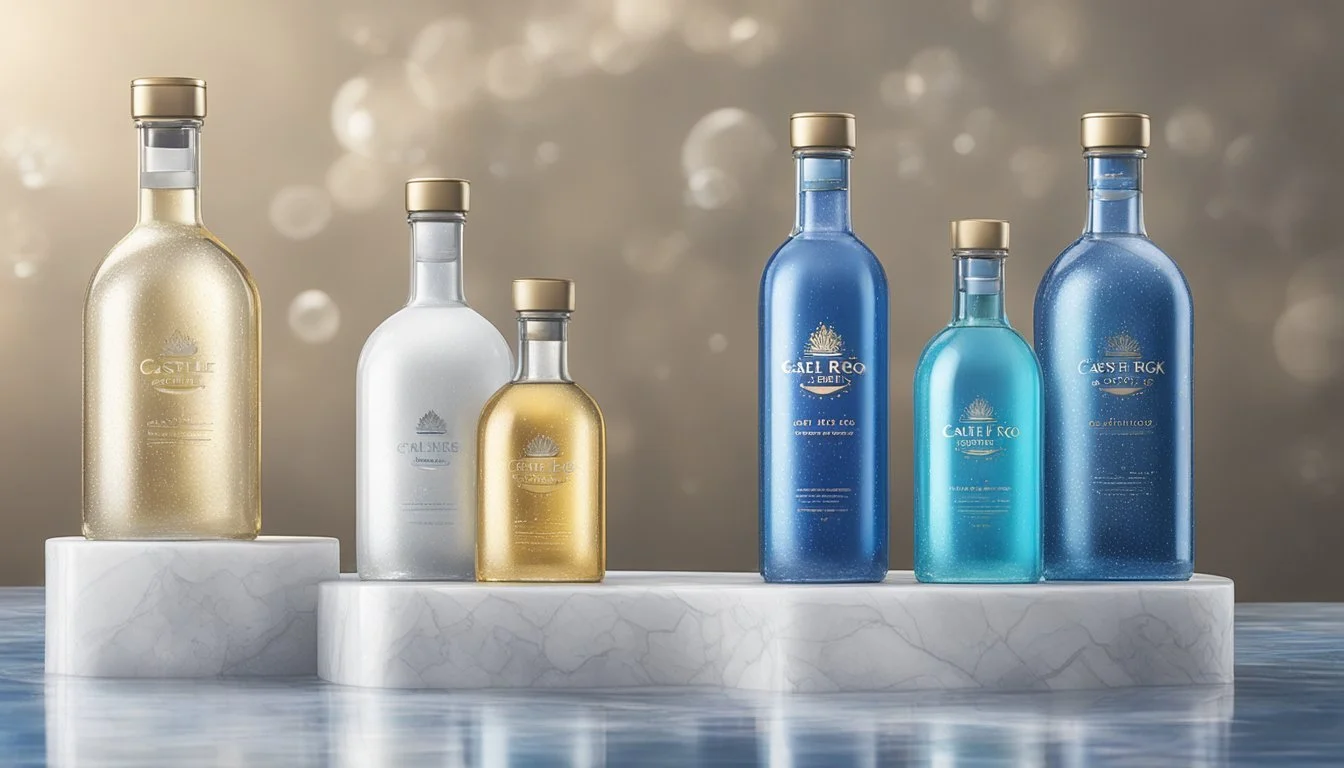Castle Rock vs. Cirro
A Comprehensive Comparison of Bottled Water
Choosing the best bottled water can elevate your hydration experience, especially when pitting Castle Rock against Cirro. When it comes to taste, Castle Rock boasts a crisp, clean flavor, revered by many for its refreshing quality. Cirro, on the other hand, offers a slightly mineral-rich profile, appealing to those who enjoy a more robust water taste.
Castle Rock sources its water from natural springs in the Sierra Nevada, ensuring that each bottle contains naturally filtered and pure water. Cirro prides itself on its meticulous purification process, removing contaminants while preserving essential minerals for a balanced taste.
Both brands are committed to sustainability and quality, but Castle Rock’s dedication to bottling in eco-friendly glass containers gives it an edge for environmentally conscious consumers. As you aim to make an informed choice, these differences highlight why enthusiasts might prefer one brand over the other.
Understanding Bottled Water
Bottled water has become a staple in many households due to its convenience and the perception of increased safety and purity. It’s crucial to understand what differentiates various types of bottled water and how they compare to municipal sources.
The Basics of Bottled Water
Bottled water is packaged drinking water, often sourced and sold for consumer consumption. Convenience, hygiene, and taste preferences are primary reasons for its popularity. Regulations for bottled water are often stringent, ensuring it meets specific quality standards. The water can be filtered, ozonated, or treated to remove impurities, and it’s usually available in plastic or glass bottles.
Types of Bottled Water
Bottled water comes in several varieties, each with distinct properties:
Spring Water: Derived from an underground formation and must flow naturally to the earth's surface.
Mineral Water: Contains minerals and trace elements from its natural source without added minerals.
Purified Water: Subjected to processes like distillation, deionization, or reverse osmosis to meet certain purity standards.
Artesian Water: Comes from a confined aquifer where water is under pressure.
Spring Water vs. Tap Water
Spring water and tap water are two commonly compared sources. Spring water comes from natural springs and often claims a more natural taste due to the presence of dissolved minerals. Tap water, sourced from lakes, rivers, or wells, is treated extensively to meet public health standards. The advantage of spring water lies in its perceived purity and mineral content, while tap water's benefit is its accessibility and regulation by local authorities.
Understanding these differences helps consumers make informed choices based on factors like taste, convenience, and health.
Profile of Castle Rock
Castle Rock water is known for its high-quality spring water sourced from Mount Shasta. Their products are recognized for their natural filtration and environmentally friendly packaging.
History and Origin
Castle Rock water originates from the pristine springs of Mount Shasta in Northern California. This region is renowned for its natural beauty and clean water sources. The springs have provided reliable and pure water for generations, attracting settlers due to their reputed health benefits. Castle Rock tapped into these resources, ensuring minimal processing to maintain the water's natural minerals and taste.
Castle Rock Water Company
Castle Rock Water Company is dedicated to delivering premium bottled water while maintaining environmental sustainability. They focus on eco-friendly practices, evidenced by using bottles made from 55% recycled glass. Their commitment extends beyond just packaging, emphasizing responsible sourcing and community engagement. The company sells its products primarily at Whole Foods markets, ensuring access to a health-conscious customer base.
Quality and Filtration Process
The quality of Castle Rock water stems from its natural filtration through the volcanic rock of Mount Shasta. This process enriches the water with naturally occurring minerals, providing a clean and refreshing taste. The water undergoes minimal processing to retain these qualities. Regular testing is conducted to ensure that the water meets stringent safety and purity standards, reflecting the company's dedication to offering one of the purest spring waters available.
Profile of Cirro
Cirro is one of the notable brands in the bottled water market, distinguishing itself through meticulous sourcing and purification methods. This section delves into the specifics of what makes Cirro unique.
Brand Overview
Cirro has carved a niche in the bottled water industry by focusing on quality and purity. The brand's reputation is built on transparency and rigorous quality control measures. Known for its sleek branding and commitment to health, Cirro often markets itself toward health-conscious consumers.
Cirro's packaging is designed to be both functional and aesthetically pleasing. The company often uses recyclable materials, emphasizing its dedication to environmental sustainability. This attention to detail helps Cirro stand out in a crowded market.
Production and Sourcing
Cirro sources its water from underground aquifers. These aquifers are known for their purity and mineral content. By tapping into these natural sources, Cirro ensures that the water maintains a consistent taste profile, free from contaminants. The location of these aquifers is carefully selected to avoid industrial or agricultural pollutants.
Groundwater extraction is done using sustainable methods that minimize environmental impact. Cirro conducts regular tests to monitor the aquifers' health and local ecosystem, ensuring the sustainability of their water sources. This approach underscores the brand’s commitment to both quality and environmental responsibility.
Purification Techniques
Cirro employs a series of advanced purification techniques to guarantee the safety and purity of its water. The process typically starts with reverse osmosis, a method that removes impurities and contaminants through a semi-permeable membrane. This step is critical for ensuring that the water is free from harmful substances.
In addition to reverse osmosis, Cirro uses additional filtration methods to further purify the water. These include carbon filtration and UV treatment, which ensure the elimination of any remaining impurities. This multi-step approach guarantees that the water is not only clean but also retains essential minerals that contribute to its taste.
By combining reverse osmosis with other filtration methods, Cirro provides a product that meets stringent quality standards. This rigorous purification process is a cornerstone of the brand’s promise to deliver pure, refreshing water to its consumers.
Health and Hydration
Castle Rock and Cirro both offer distinct hydration benefits and are viewed differently by water sommeliers in terms of health and taste attributes.
Hydration Benefits
Castle Rock sources its water from natural springs, providing naturally occurring minerals and electrolytes. These elements can aid in hydration and potentially offer added health benefits. The presence of minerals like calcium and magnesium is important for bodily functions.
Cirro, with its focus on purified water, goes through extensive filtration and often has added minerals to enhance taste and hydration efficiency. Users might prefer this for its purity and controlled mineral content. While both brands hydrate efficiently, the mineral content difference plays a significant role.
Water Sommelier Insights on Hydration
Water sommeliers often highlight the subtle taste nuances that minerals bring to natural spring waters like Castle Rock. The richness of naturally occurring minerals makes it a preferred choice for those seeking more than basic hydration. It is praised for its refreshing quality and health benefits due to its natural content.
Cirro's purified approach removes impurities and then adds back select minerals, creating a consistent and clean taste appreciated by many consumers. Sommeliers note that this method ensures uniform quality, making it a reliable choice for those focused strictly on hydration without the richer mineral profile of natural waters.
Environmental Impact and Sustainability
The environmental impact of bottled water and the sustainability practices of Castle Rock and Cirro are critical factors in determining which brand is more eco-friendly. This section explores the materials used in their bottles and their recycling efforts, as well as the overall environmental footprint of each brand.
Bottle Materials and Recycling
Castle Rock uses primarily glass bottles, which are highly recyclable and can be reused multiple times without degrading in quality. Glass is considered an environmentally friendly material due to its durability and low contamination risk during the recycling process.
Cirro, on the other hand, uses PET plastic bottles, which are also recyclable but require more energy to produce and recycle compared to glass. PET can be recycled into fibers for clothing or containers, but only a fraction of plastic bottles are ever recycled. FDA regulations ensure the safety of materials used in both brands, but sustainability practices and consumer habits significantly affect the environmental burden.
Environmental Footprint
Producing glass bottles for Castle Rock involves more energy and raw materials initially, but the capacity for multiple reuses offsets this impact over time. Glass production does emit carbon during manufacturing, though its high recyclability plays a crucial role in minimizing long-term environmental effects.
Cirro’s PET bottles have a lower upfront energy cost but result in a larger environmental footprint due to lower recycling rates and higher chances of contributing to landfills or ocean pollution. Compared to tap water, bottled water production for both brands imposes significant environmental costs. For instance, new studies indicate that bottled water has an impact up to 3,500 times greater than tap water in terms of resource extraction and ecosystem disruption.
Considering these factors, the environmental sustainability of Castle Rock and Cirro largely depends on how effectively their bottles are recycled and the broader adoption of environmentally friendly practices by consumers.
Taste Test and Comparison
Castle Rock and Cirro waters each offer distinct flavor profiles, catering to different preferences. Evaluations by both consumers and experts highlight key taste characteristics and preferences that set these brands apart.
Water Taste Profiles
Castle Rock features a crisp, clean flavor reminiscent of mountain spring water. This refreshing quality is often praised for its lack of aftertaste, allowing for a pure drinking experience. The water is described as crystal clear with a hint of natural minerals, contributing to its fresh profile.
Cirro, on the other hand, presents a more neutral flavor. It is designed to be smooth and subtly refreshing, making it an easy choice for those who prefer a mild taste. This water is filtering to remove most impurities, resulting in a soft mouthfeel that appeals to a wide audience.
Consumer Preferences
Consumers often favor Castle Rock for its invigorating and crisp taste. Many describe it as having a refreshing quality that quenches thirst effectively. The absence of an aftertaste makes it a popular choice among those seeking a clean and straightforward water option.
Cirro attracts consumers looking for a neutral and mild taste. Its soft water profile makes it especially appealing for everyday consumption, avoiding any overwhelming flavors. This versatility has helped Cirro build a loyal consumer base who appreciate its consistently smooth and gentle taste.
Expert Opinions
Experts commend Castle Rock for its natural spring origin and mineral content. The water's crispness is attributed to its source and minimal processing, which preserves its fresh taste. The absence of an aftertaste is often highlighted as a standout feature.
Cirro is praised for its advanced filtration process that ensures a pure, neutral flavor. This meticulous filtration not only removes impurities but also aims to deliver a consistent taste. Experts note that Cirro's soft texture and mild taste make it a versatile option that can appeal to a broad range of palates.
Each bottled water brand carves out its niche through distinctive taste profiles, consumer preferences, and expert endorsements, providing ample choices for a refreshing hydration experience.
Market Presence and Availability
Castle Rock and Cirro have distinct retail and online presences, with varying degrees of availability in the United States and Canada. This section will explore their distribution channels and how easy it is for consumers to find these brands.
Retail Distribution
Castle Rock is widely available in many grocery stores across the United States, particularly on the West Coast and in major urban centers like New York. Its presence in Canada, while growing, is still limited compared to its US availability. Most large retailers and specialty stores carry Castle Rock, making it a convenient choice for many consumers.
Cirro, on the other hand, has a more selective distribution strategy, focusing on premium retailers and high-end supermarkets. While it may not be as ubiquitous as Castle Rock, Cirro can be found in select grocery chains both in the US and Canada. This targeted approach ensures that Cirro maintains an exclusive image, although it may not be as easily accessible in all regions.
Online Presence
Castle Rock has a robust online presence, with its products available on major e-commerce platforms such as Amazon and Walmart. The brand also offers direct sales through their official website, often providing seasonal discounts and subscription services. This online accessibility ensures that consumers nationwide, including those in remote areas, can easily purchase Castle Rock water.
Cirro's online availability is equally strong, with listings on popular sites like Amazon and specialty food and beverage platforms. Their official website features a sleek design and offers options for one-time purchases and subscriptions. This not only makes Cirro accessible to a broader audience but also reinforces its premium market positioning with exclusive online offers.
Both Castle Rock and Cirro leverage a combination of physical and online retail channels to reach their customers, each brand’s strategy reflecting its market positioning and target demographics.
Comparative Analysis
Castle Rock and Cirro are two notable players in the bottled water market, each with distinct qualities and consumer bases. This comparative analysis will cover direct taste and quality comparisons, consumer reviews, and price points.
Direct Comparison
When comparing Castle Rock and Cirro, taste and purity are vital benchmarks. Castle Rock is known for its pristine sources in the Sierra Nevada Mountains, often touted for its fresh and clear taste.
Cirro, on the other hand, prides itself on its multi-stage filtration process, which aims to ensure a consistent and neutral taste. Comparatively, drinkers often describe Castle Rock as having a slightly more "natural" mineral profile, while Cirro is praised for its crispness.
Consumer Reports and Reviews
Consumer feedback plays a crucial role in assessing bottled water brands. Reports and reviews from platforms like Consumer Reports indicate that Castle Rock scores highly for taste and mineral content.
Consumers appreciate its smooth texture and eco-friendly packaging. Cirro also receives favorable reviews, particularly for its consistent taste and accessibility. However, some users note a preference for Castle Rock's natural taste when conducting blind taste tests.
Price Point Evaluation
Price is a decisive factor for many consumers. Castle Rock is positioned as a premium brand, often reflecting higher costs due to its sourcing and packaging standards.
Cirro, while still a high-quality product, generally falls into a more mid-range price category. This makes Cirro an appealing option for cost-conscious consumers seeking reliable and great-tasting bottled water. In terms of cost-to-quality ratio, both brands offer substantial value, but Castle Rock commands a premium for its purportedly superior natural qualities.
Conclusion
When comparing Castle Rock and Cirro bottled waters, several factors stand out.
Taste:
Castle Rock offers a crisp and clean taste. Cirro, on the other hand, has a softer, smooth profile.
Source:
Castle Rock sources its water from natural springs, ensuring a pristine and unaltered experience. Cirro often uses municipal sources that undergo rigorous purification processes.
Mineral Content:
Castle Rock boasts a balanced mineral composition, enhancing its natural flavor. Cirro's water is similarly mineral-rich but carefully filtered to maintain consistency.
Packaging:
Castle Rock uses eco-friendly packaging, reflecting a commitment to sustainability. Cirro also prioritizes environmentally friendly packaging, with a focus on recyclability.
Price Point:
Castle Rock is priced slightly higher, reflecting its premium sourcing and packaging. Cirro offers a more budget-friendly option while maintaining high standards of quality.
For those seeking natural spring water with a strong emphasis on environmental impact, Castle Rock is recommended. Cirro is suitable for consumers who prioritize a balance between quality and cost.







